ISSN ONLINE(2278-8875) PRINT (2320-3765)
ISSN ONLINE(2278-8875) PRINT (2320-3765)
S.M. Shashidhara1, Dr.P.S. Raju2
|
| Related article at Pubmed, Scholar Google |
Visit for more related articles at International Journal of Advanced Research in Electrical, Electronics and Instrumentation Engineering
Through this paper issue of on-line detection of short winding fault in three-phase induction motors is presented, and a technique, based on the computer-aided monitoring of the stator current Park’s Vector, is proposed. The park's vector model is realized by employing Virtual instrumentation. The Virtual Instrumentation is acquired by programming in Lab-view software. Laboratory analysis was performed on a 0.5 hp three phase induction motor. The motor was originally evaluated under optimum circumstances and Park's vector model was sketched. Subsequently, the short winding fault is reproduced in the motor. The motor was scrutinized again under erroneous condition and Park's vector model was sketched. Both plots were then scrutinized. It is ascertained that current park's vector pattern of healthy motor was perfect circle meanwhile current park's vector pattern under faulty condition was elliptical in shape. Experimental conclusion, derived by employing a distinct fault producing test rig, illustrate the efficiency of the suggested modus operandi, for determining the presence of short winding fault in running three-phase induction machines.
Keywords |
| Induction motor, Stator winding inter-turn fault, Park’s vector, LabVIEW. |
INTRODUCTION |
| There is a consensus that 35-40 % of induction motor breakdowns are attribuetd to the stator winding insulation [1]. Furthermore, it is normally assumed that a significant part of stator winding- connected failures are instigated by insulation failures in multiple turns of a stator coil within one phase. This kind of fault is known as a “stator turn fault” [2]. |
| A stator turn fault in a symmetrical three-phase AC machine triggers a high circulating current to flow and therefore produces unwarranted heat in the shorted turns. If the heat relative to the square of the circulating current surpasses the limiting magnitude a absolute motor failure may transpire [3]. Nonetheless, the worst outcome of a stator turn fault may be a severe accident concerning loss of life. The organic materials employed for insulation in electric machines are prone to degradation from a combination of thermal overloading and cycling, transient voltage stresses on the insulating material, mechanical stresses, and impurities. Among the probable causes, thermal stresses are the primary cause for the deterioration of the stator winding insulation. Stator winding insulation thermal stresses are classified into three categories: aging, overloading, and cycling [4]. Even the most superior insulation may fall short if motor is run beyond its temperature limit. As a convention, the life span of the insulation is diminished by 50% for every 10ºC raise over the stator winding temperature limit [5]. Therefore it is necessary to check the stator winding temperature so that an electrical machine won’t operate past its thermal capacity. For this reason, numerous methods have been put forward [6]-[8]. Nonetheless, the inherent constriction of these methods is their incapacity to perceive a restricted hot spot at its primitive stage. |
| Some mechanical difficulties that hasten insulation degradation incorporates movement of a coil, vibration due to rotor unbalance, slack or worn bearings, air gap peculiarity, and damaged rotor bars . The current in the stator winding results in a force on the coils that is proportional to the square of the current. This force is at its greatest under transient overloads, resulting in the coils to pulsate at twice the synchronous frequency with shifting in both the radial and the tangential direction. This movement deteriorates the reliability of the insulation system. Mechanical faults, such as damaged rotor bar, worn bearings, and air-gap eccentricity, may be a cause why the rotor hits the stator windings. Hence, such mechanical failures should be identified before they breakdown the stator winding insulation [9,10]. Contamination due to unknown materials can result in undesirable outcomes on the stator winding insulation. The presence of foreign contaminants can cause a decline in heat dissipation [11]. It is therefore of utmost important to keep the motors dirt free and dry, in particular when the motors runs in a hostile environment. |
| Despite of the causes, stator winding-related breakdown can be segregated into five types: turn-to-turn, coil-to-coil, line-to-ground, l i n e -to-line, and open-circuit faults. Among the five failure modes, turn-to-turn faults (stator turn fault) is supposedly the most challenging one since the other forms of breakdowns are generally the result of turn faults. |
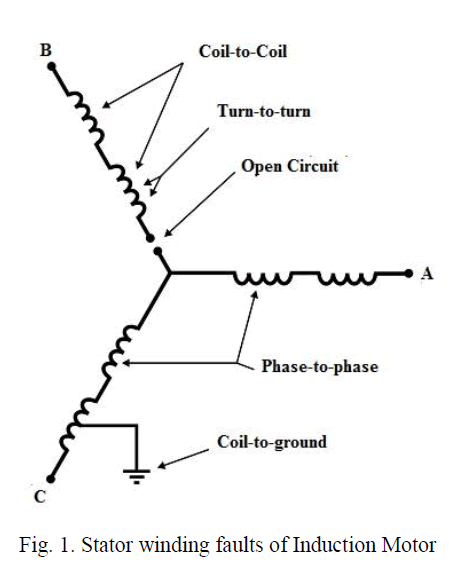 |
| In addition, turn faults are very arduous to identify at their primitive juncture. To crack the difficulty in identifying turn faults, many techniques have been devised [12]-[14]. In this thesis, short winding fault is diagnosed with Park's Vector method. |
II. DETECTION OF FAULTS USING PARK’S VECTOR METHOD |
| One of the difficulties encountered in the analysis and description of the behavior of most rotating electric machines is that the inductances are functions of the relative position of the rotor and stator. In order to simplify the study of the electrical machines R.H. Park formulated a transformation that made their analysis more straightforward by transforming the motor equations into a two-phased orthogonal frame of reference. The transformation of the three-phased system to the two-phased orthogonal system can be performed upon: |
 (1) (1) |
| where f is the function to be transformed (it can be the current, voltage or magnet ic flux). The Park transformation matrix is given by: |
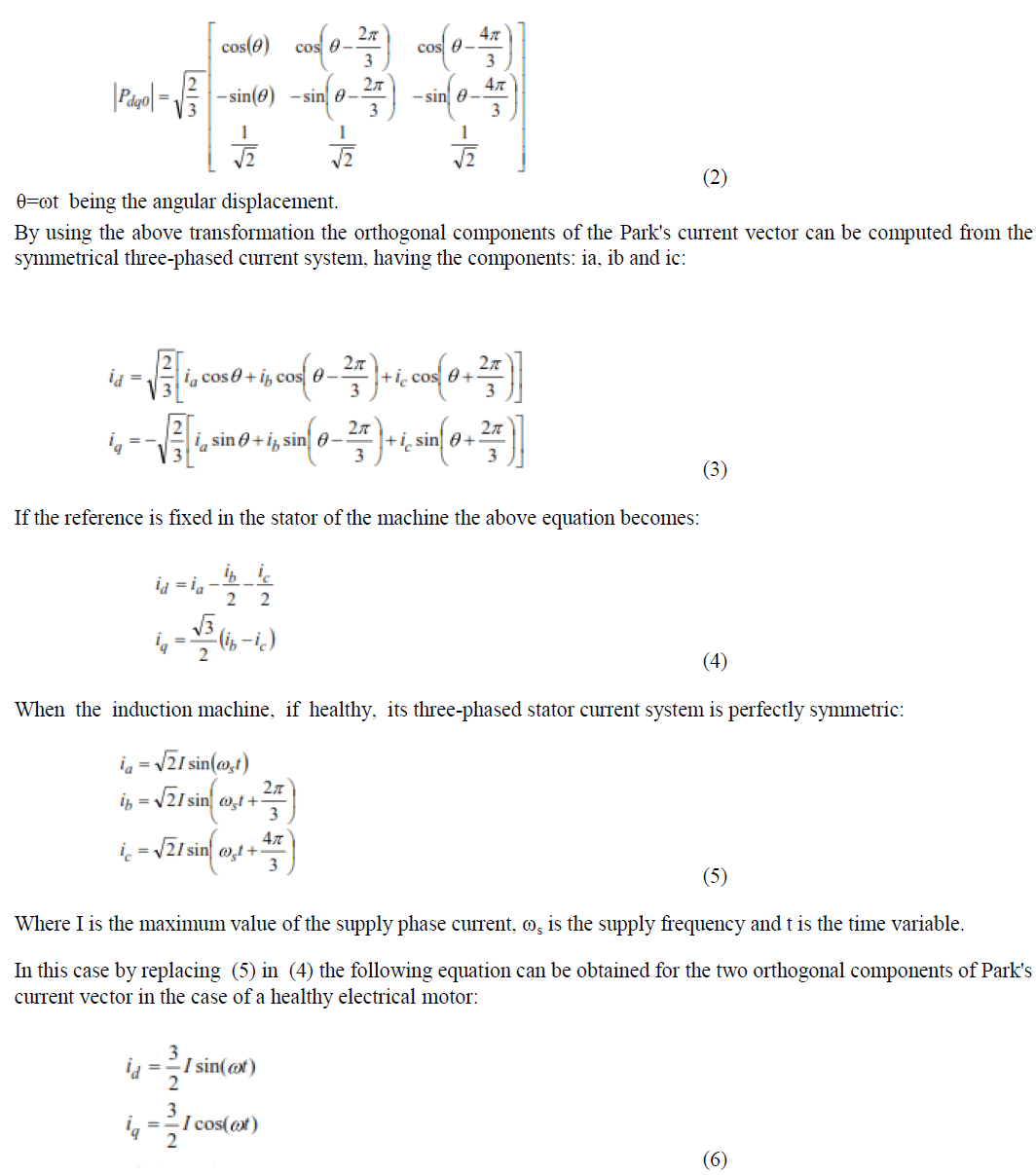 |
| Upon equation (6) it can be expressed that a healthy machine shows a perfect circle in Park's vector representation, as shown in Fig 4. When any type of fault occurs the three-phased current phase current system becomes unbalanced. This results in an elliptic representation of the Park's current vector. |
| Its representation is a circular pattern centered at the origin of the coordinators as depicted in Fig 2. It’s a straightforward reference figure that permits the identification of anomalous conditions by observing the deviations of acquired patterns. |
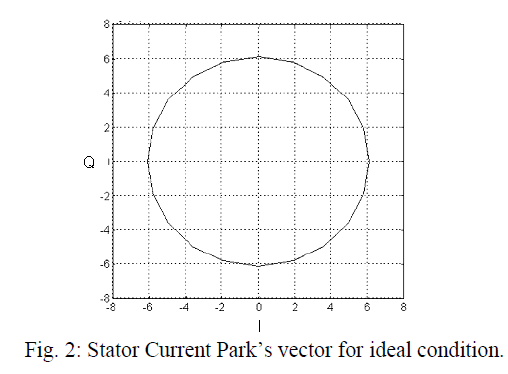 |
| Short winding fault can be effectively diagnosed with Park’s vector approach. The study of the three -phase induction motor can be simplified with the help of the Park transformation. This technique is based on the visualization of the motor current Park’s vector model. If it’s a perfect circle then the machine can be considered as healthy. If the observed pattern is elliptical, the machine is erroneous. Using the features of the ellipse, the fault's type can be determined. The ellipticity amplifies with the acuteness of the fault. |
III. EXPERIMENTAL SETUP |
| To determine the fault of induction motor with high precision, a modern laboratory test bench was arranged. Fig 3 shows schematic diagram of the induction motor test facility. The system consists of an induction motor, variable speed controller, supporting bearings, couplings and DC generator as a load, NI data acquisition card PCI-6251, data acquisition board ELVIS and Pentium-IV Personnel Computer with software LabVIEW 8.2. Rated data of the tested three-phase squirrel cage induction machine were: 0.5 hp, 415V, 1.05 A and 1380(FL) r/min. The constraints of motor employed in the experiment are provided in Table 1. LabVIEW 8.2 software has been employed to scrutinize the signals. It’s simple to obtain any measurement with NI LabVIEW. |
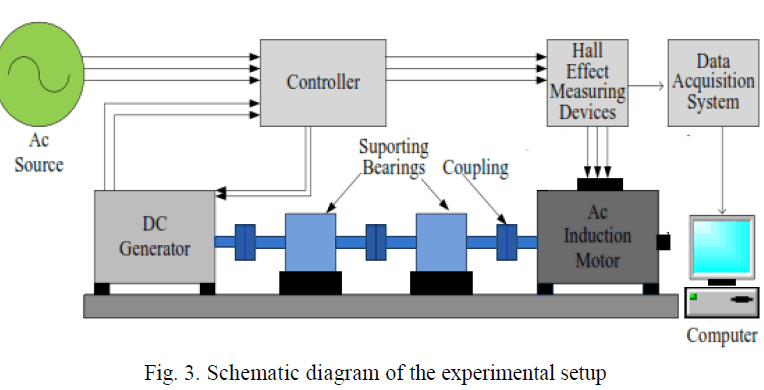 |
| The measurements may be automated from multiple devices and the acquired data can be evaluated simultaneously using LabVIEW. Data acquisition card PCI-6251 and acquisition board are employed to obtain the current samples from the motor under load. NI high-speed multifunction data acquisition (DAQ) device can estimate the signal with enhanced precision at high speed sampling rates. The apparatus has six DMA channels for high-speed data output. Onboard is a NI-PGIA2 amplifier fabricated for fast settling times at high reading rates, which ensure 16-bit accuracy even when estimating all channels at maximum speeds. This apparatus has 24 digital I/O lines, a minimum of 16 analog inputs, seven programmable input ranges and two counter/timers. |
| The NI ELVIS incorporates 12 of the most frequently used devices - comprising the oscilloscope, DMM, function generator, and Bode analyzer - into a compressed form suitable for the hardware lab. Based on NI LabVIEW graphical system design software, NI ELVIS provides the tenacity of virtual instrumentation and permits for speedy and simple measurement acquirement and display. In the study, the speed of the motor is computed by digital tachometer. The virtual instrument (VIs) was set up using programming in LabVIEW 8.2. The VIs was employed both for manipulating the test measurements and data acquisition. In order to assess the system under practical conditions, numerous measurements were made to obtain the stator current of the motor. The 3-ph IM is of 415V, 0.5 hp, f=50Hz, 1500 rpm, 2 pole pairs and 36 rotor slots. |
| To obtain the Park’s vector pattern, the programming is performed with signal processing module of LabVIEW software. The induction motor was initially scrutinized, in the absence of faults so as to find the reference current Park’s vector pattern relative to the supposed optimum motor. Later, short circuited motor was evaluated. A time window of 175ms was employed for all data acquisition so as to obtain a simple and detailed pattern. The sample rate was 2000 sample/second. The number of samples taken was 350. |
IV. OBSERVATIONS |
| Fig 4 illustrates a Current Park’s vector pattern for optimum motor which is a perfect circle in which instantaneous magnitude is unvarying. |
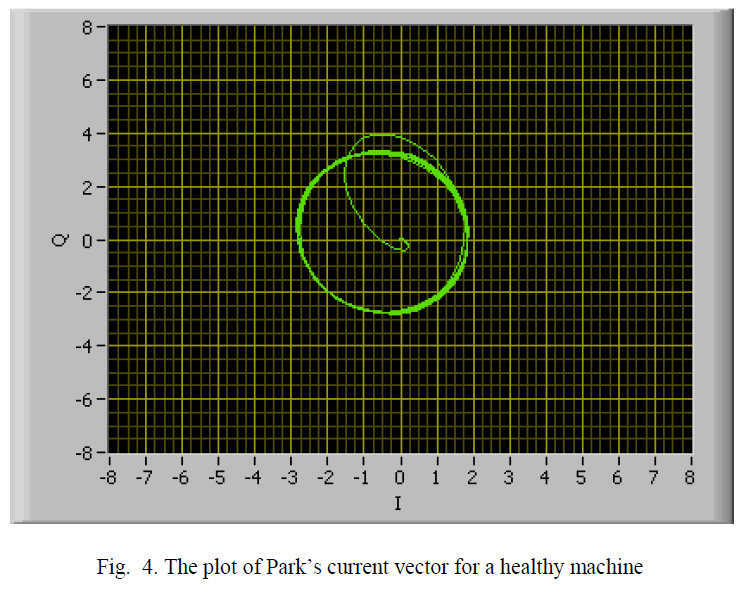 |
| An unbalance due to short winding faults results in diverse representation of the park’s vector is depicted in Fig 5. It can be noted that current pattern for erroneous motor is obviously different from that of the optimum motor. The shape of the current's phasor in Fig 5 is not of a perfect circle. The elliptical shape of current’s phasor shows short winding fault in the squirrel cage induction machine. Hence, by evaluating the current pattern of healthy and faulty motor, the short winding fault can be easily identified. |
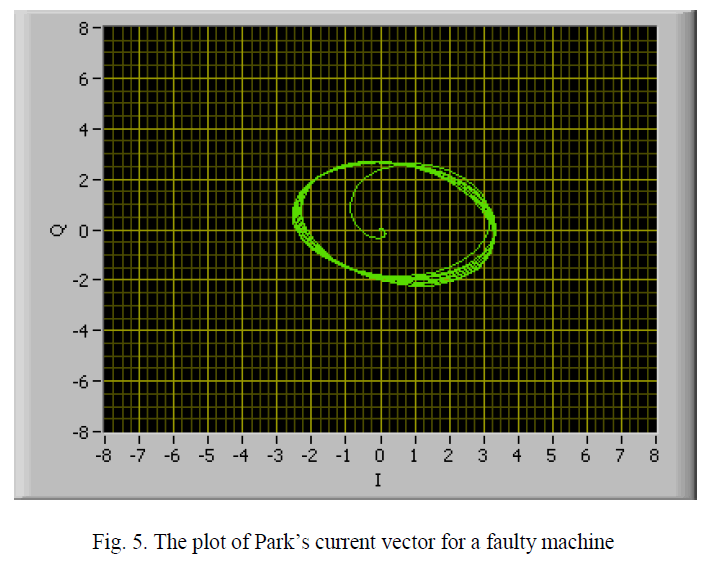 |
V. CONCLUSIONS |
| With the help of this paper a methodology by which induction motors electrical faults can be identified by observing the stator current has been proposed. The suggested technique was based on the Park’s vector approach. S tator current Park’s vector patterns were employed to distinguish between 'healthy' and 'faulty' induction motor. The results derived from the experiment prove that current park's vector pattern of healthy motor was perfect circle while current park's vector pattern under faulty condition was elliptical in shape. Using this, the short winding fault of induction motor can be easily determined by evaluating the Park's vector representations. Hence, the laboratory experiment establishes the efficiency and effectiveness of this method in area of computer aided condition monitoring of induction machines. |
References |
|